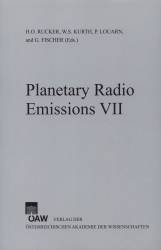
Planetary Radio Emissions VII, pp. 209-218, 2011/12/28
Proceedings of the 7th International Workshop on Planetary, Solar and Heliospheric Radio Emissions held at Graz, Austria, September 15–17, 2010

The new mechanism for the formation of a fine structure in the dynamic spectra of the Jovian decametric radio emission is proposed. The main attention is paid to the formation of narrow-band (NB) emission and quasiperiodic trains of S-bursts. Our model is based on the effects of occurrence of the amplitude-frequency modulation and extension of the frequency spectrum of a signal during propagation of the radiation in a medium with time-varied parameters. It is shown that non-stationary disturbances of the planetary magnetic field and strong frequency dispersion of the plasma at frequencies close to the cutoff frequency of the extraordinary wave in the Jovian ionosphere can play a crucial role in the formation of NB emission and quasiperiodic trains of S-bursts. As a result of the numerical experiments, it was concluded that the amplitude-frequency characteristics of an initially continuous signal can drastically vary as functions of the form of the magnetic-field disturbance in the Jovian ionosphere. Structures similar to those observed in the real experiments, ranging from NB emission and quasiperiodic trains of S-bursts to more complex structures, arise in the dynamic spectrum.